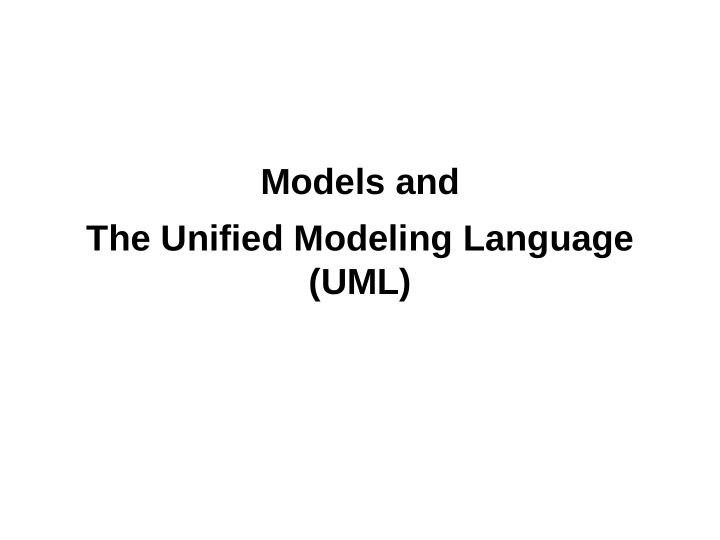



Models and The Unified Modeling Language (UML)
What is a Model: Maps Models are abstractions of the real situation to give a clearer view of some aspect. Maps are models of some region terrain and geography. Suppress details (buildings, etc.) in interest of clarity.
What is a Model: Maps Models are abstractions of the real situation to give a clearer view of some aspect. Maps are models of some region terrain and geography. Suppress details (buildings, etc.) in interest of clarity. BUT I have a map of the United States... Actual size. It says, 'Scale: 1 mile = 1 mile.' I spent last summer folding it. I hardly ever unroll it. People ask me where I live, and I say, 'E6'. Steven Wright
Other Models Airplane models • Blueprints • Wiring diagrams • Building maps • Weather maps • Key point: Abstraction from details to get a • better overall view.
Software Models JavaDoc documents • UI Mockups • Entity-Relationship Diagrams • • X UML ( U ni.. M odeling L anguage) ➔ UML ( U nified M odeling L anguage) •
Quick UML History OO Technology in general "took off" in the late 80s and • early 90s. Diagrams for previous technologies inadequate. • Competing OO notations arose to address this problem. • Mid-90s: UML integrated three of the most prominent • notations: – Grady Booch – James Rumbaugh – Ivar Jacobsen
UML Diagram Types Structural : How do pieces fit together? – Class (static components) – Object diagrams (run-time examples) – Component (packaging) – Deployment (distribution) Behavioral / dynamic : How to pieces interact? – Use cases (interaction with external entities) – Sequence (internal object interactions over time) – Collaboration (isomorphic to sequence) – Statecharts (finite state machines) – Activity (concurrency) – Timing (primarily for real-time)
UML Diagram Types Structural : How do pieces fit together? – Class (static components) – Object diagrams (run-time examples) – Component (packaging) – Deployment (distribution) Behavioral / dynamic : How to pieces interact? – Use cases (interaction with external entities) – Sequence (internal object interactions over time) – Collaboration (isomorphic to sequence) – Statecharts (finite state machines) – Activity (concurrency) – Timing (primarily for real-time)
UML Diagram Types Class Diagrams (isa Static model) – Classes & interfaces optionally with state & methods. – Generalization (inheritance): extends / implements. – Interobject associations. Object Diagrams - run-time examples conforming to the class diagram. Sequence Diagrams (isa Dynamic model) – Objects & lifelines – Calls and returns ON TO LUCIDCHART!
Recommend
More recommend